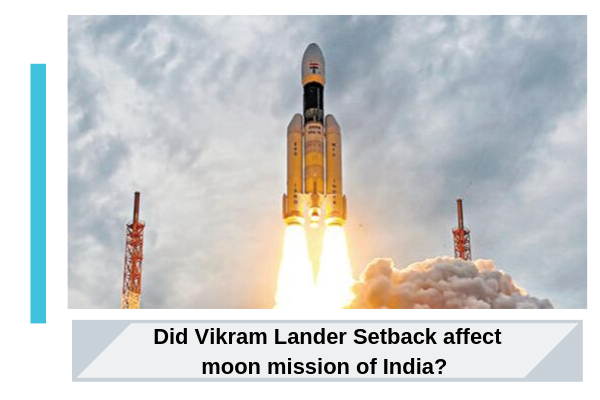
Here everything is explained in Detail
India’s visionary and most talked mission Chandrayaan 2 to soft-land the Vikram lander that carried a Pragyan Rover wasn’t 100% successful. However, the orbiter is successfully running its business. Chandrayaan 2 took off from Sriharikota to the south pole of the moon on July 22 in a suitable high plain on the lunar surface at a latitude of about 70 degrees South. The bad news came on September 7 minutes before the ‘Vikram Lander’ was about to land at 1:50 a.m. when ISRO lost its contact with the module.
The journey of Chandrayaan 2
Chandrayaan 2 compromising an orbiter, a rover and a Lander journeyed for more than a week and reached the moon’s vicinity on August 20. The Lander separated from the orbiter on 2nd September. The orbiter started moving around moon pole-to-pole at a speed of 100 km to a distance of 35 km.
The mission planners of ISRO (Indian Space Research Organization) had divided the last critical 15-minute parabolic into four little phases. The Lander perfectly cleared the ‘rough braking phase’ at 1:38 a.m. IST on September 7. It swoops down from 30 km to 7.4 km of the lunar surface in 10 minutes. The velocity had dropped as required from 1,640 metres a second to about 400 m/s.
It then entered the ‘fine braking phase’ second part, of 3 minutes. The four throttleable motors then switched off to further lower the velocity. It was supposed to re-orient itself and take pictures of the moon surface to look for hazards like slopes and rocks. When the moon surface was just 2.1 km and 2 minutes away from the landing, green lines at Bengaluru headquarters showed that the scientists were not able to receive any signal from the Lander.
The Lander along with its rover had developed a problem. It crashed at the fag end of a visionary journey and gone silent. 20 minutes later, the disappointed ISRO Chief K. Sivan announced that ISRO has lost its contact with Vikram. The Country went silent, eyes got filled with tears, mouth went numb but then came Prime Minister Narendra Modi who praised the scientists for their amazing work.
The failure analysis committee is working to find out what went wrong with the Vikram Lander. Was it the over-performance of thrusters or the Lander lost altitude so badly that it didn’t recover?
NASA had recently put images on the social media which asserted the hard landing of Vikram Lander. However, it is not certain that the image is of Vikram Lander.
How important was this mission?
This was India’s second attempt to reach Moon after Chandrayaan 1 in 2008. The first mission was an orbiting mission which died just after 8 months. It confirmed the presence of water molecules on the lunar surface. Chandrayaan 2 planned to take off from where the Chandrayaan 1 left. One of the main ambition was to look intensively for water deposits from up close. The formidable combination of an orbiter, a lander and a rover aimed to look at the moon’s exterior, interior and surface in that order.
Challenges for Chandrayaan 2?
The biggest challenge for this mission was to soft-land on the moon. The spacecraft had to land intact, unharmed and remain in touch with earth to do its assigned job. About 80 missions have been sent to the moon since the early 1960s, in which 60% have failed. Israel Beresheet craft crashed on the moon in April 2019 and mission was unsuccessful. China’s Chang’s 4 mission in January this year was the first mission to land on the far side of the moon in January and it also deployed a Rover.
The lunar terrain is uneven and rocky. The moondust is unstable as it slowly rises and falls while landing. The moondust and the gravity of the moon that is 17% of the earth can disable sensitive instruments of a lander. However, the Vikram lander was equipped with new technology. It had autonomous rover, the lander and its legs, and the four throttleable motors.
Read more: How Modi–Trump Bromance can help India?
What follows in future?
The harsh truth is, India did not arrive on the moon. India wanted to become the fourth member of the lunar club after the Soviet Union, America and China. However, all the efforts in 10 years have not gone in vain, the orbiter is still at work. The orbiter is gliding 100 km above the moon and continues to bear the torch for Chandrayaan 2. It is beaming pictures of the moon. The information will send when it revisits the landing site of Lander might offer precious lessons for future planetary missions for the country.
Have a news story, an interesting write-up or simply a suggestion? Write to us at info@oneworldnews.com








